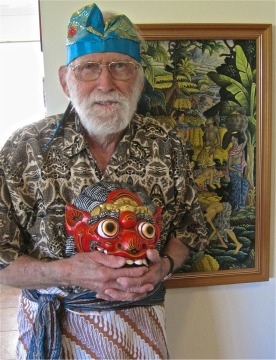Introduction to Bali
 This study of a traditional lifestyle under threat is, at one and the same
time, one of the most dated and the most recent of the studies of "Cultures
in Context" posted on the World Wide Web. This is because all of the images
were collected during a short holiday in 1984. They were used during my
visits to schools, but were not scanned for internet use till recently.
This study of a traditional lifestyle under threat is, at one and the same
time, one of the most dated and the most recent of the studies of "Cultures
in Context" posted on the World Wide Web. This is because all of the images
were collected during a short holiday in 1984. They were used during my
visits to schools, but were not scanned for internet use till recently.
In recent years Bali has sometimes received negative
treatment in news broadcasts. Ash clouds from its volcanoes have shut down
the airport. People carrying drugs have been executed (by the Indonesian
government). And in the minds of many travellers there remains still the
memory of the “Bali Bombings” of 2002 … in the tourist district of Kuta,
when 202 people were killed and 209 injured. And while these deaths were
still fresh in the minds of survivors, a further 20 people were killed
and more than a hundred injured in suicide bomb attacks in 2005. Such atrocities
had nothing whatever to do with the traditional values of Bali, but were
the work of Islamic terrorists from elsewhere in Indonesia. The number
of tourists dropped significantly in the following years but soon recovered,
and includes a rapidly expanding group from China.
In recent decades Bali has received an influx
of Muslims from other parts of Indonesia. In the year 2000 scarcely more
than 10% of the island’s permanent population were Muslims. By 2010 it
was 15%, and in some districts much higher. Such a change is bound to influence
the way of life of Bali’s people, and generate tensions between Hindu and
Muslim residents.
The economy depends almost wholly on tourism,
and tourist numbers are highly sensitive to social unrest. Muslims are,
nevertheless, the biggest single category of visitors to the island, and
the great Muslim holiday of Eid al-Fitr is Bali's busiest time, with visitors
from Java and elsewhere jamming the island's accommodation. In addition,
a lot of management expertise and investment in tourist infrastructure
is in the hands of Muslims … and the profits accordingly moved off-shore.
In 1984 when I was there such developments would
have been unimaginable. There were sizeable hotels and night clubs
at beach resorts, but inland from the coast the day-to-day life of the
people had much in common still with the values and practices of their
ancestors. Today the greatest threat to their traditional life style is
not the number of Muslim residents but the massive influx of tourists,
and the alien practices of the five-star world, and a totally different
value system … highlighted now by the development of a “Trump” golf course
and six star resort overlooking one of Bali’s holiest shrines … Tanah Lot.
I personally have no wish to return to Bali but
I’m sure it is still worth a visit.


![]()
![]()
![]()
![]()